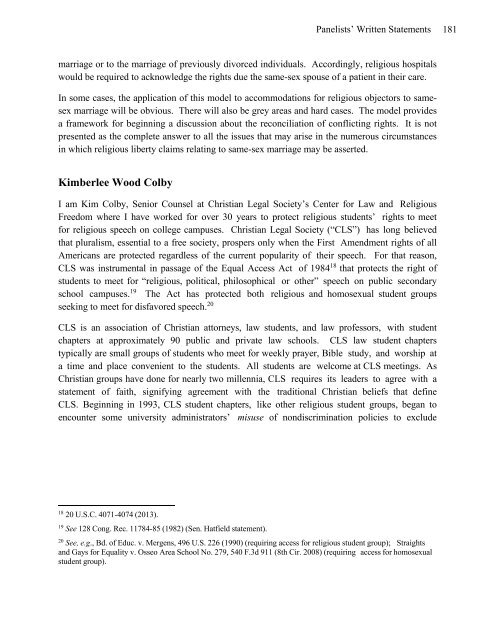PEACEFUL COEXISTENCE
2cgDkdT
2cgDkdT
Create successful ePaper yourself
Turn your PDF publications into a flip-book with our unique Google optimized e-Paper software.
Panelists’ Written Statements<br />
183<br />
that governments should oppose it when it makes sense, all things considered, and when it is<br />
within their constitutionally and morally limited powers, to do so. 23<br />
Caution needs to be taken before affixing the stigmatizing label of “wrongful<br />
discrimination” to religious groups’ exercise of a fundamental religious liberty. Reflecting<br />
an appropriate sensitivity to religious liberty, most nondiscrimination laws, including Title<br />
VII, simultaneously prohibit discrimination while protecting religious groups’ ability to<br />
maintain their religious identities.<br />
Part III analyzes the Supreme Court’s decision in Christian Legal Society Chapter of University<br />
of California, Hastings College of the Law v. Martinez, 24 a narrow decision that is easily<br />
misunderstood. In Martinez, the Court explicitly did not decide whether nondiscrimination<br />
policies could be used to penalize the religious students that they are supposed to protect.<br />
Instead, the Court narrowly, and conspicuously, confined its decision to an unusual “allcomers<br />
policy,” unique to one law school, that required all student groups to allow any<br />
student to be a member and leader of the group, regardless of whether the student agreed with—<br />
or actively opposed—the values, beliefs, or speech of the group. 25 Moreover, the Court held it<br />
was not enough for a university to adopt an “all-comers policy”: the policy must actually be<br />
uniformly applied to all student groups. 26<br />
As Part IV explains, “all-comers policies” are rare because, as the Martinez decision requires,<br />
they must be applied without exception to all student groups. As a practical matter, an “allcomers<br />
policy” is completely unworkable because of its inherent incompatibility with the<br />
sororities and fraternities, a cappella groups, and club sports teams found on most campuses.<br />
Besides ending selection of members and leaders on the basis of sex, an all-comers policy<br />
would seem to require fraternities and sororities to adopt a “first-come, first-pledge”<br />
selection process to ensure their openness to all students.<br />
A healthy balance between nondiscrimination policies and religious liberty is absolutely<br />
necessary and easily attainable. The conflict is entirely avoidable if university administrators<br />
exercise tolerance, common sense, and sensitivity to religious student groups and their basic<br />
religious liberty to be led by persons who share their religious beliefs.<br />
23<br />
Richard W. Garnett, Religious Freedom and the Nondiscrimination Norm, ch. 4 in Austin Surat, ed., Legal<br />
Responses to Religious Practices in the United States 194, 198 (Cambridge University Press, 2012). A summary of<br />
Professor Garnett’s article is found at Richard W. Garnett, Confusion about Discrimination, The Public Discourse,<br />
Apr. 5, 2012, available at http://www.thepublicdiscourse.com/2012/04/5151/ (last visited March 8, 2013).<br />
24<br />
130 S.Ct. 2971 (2010).<br />
25<br />
Id. at 2982, 2984; id. at 2999 (Kennedy, J., concurring).<br />
26<br />
Id. at 2993-2995.


